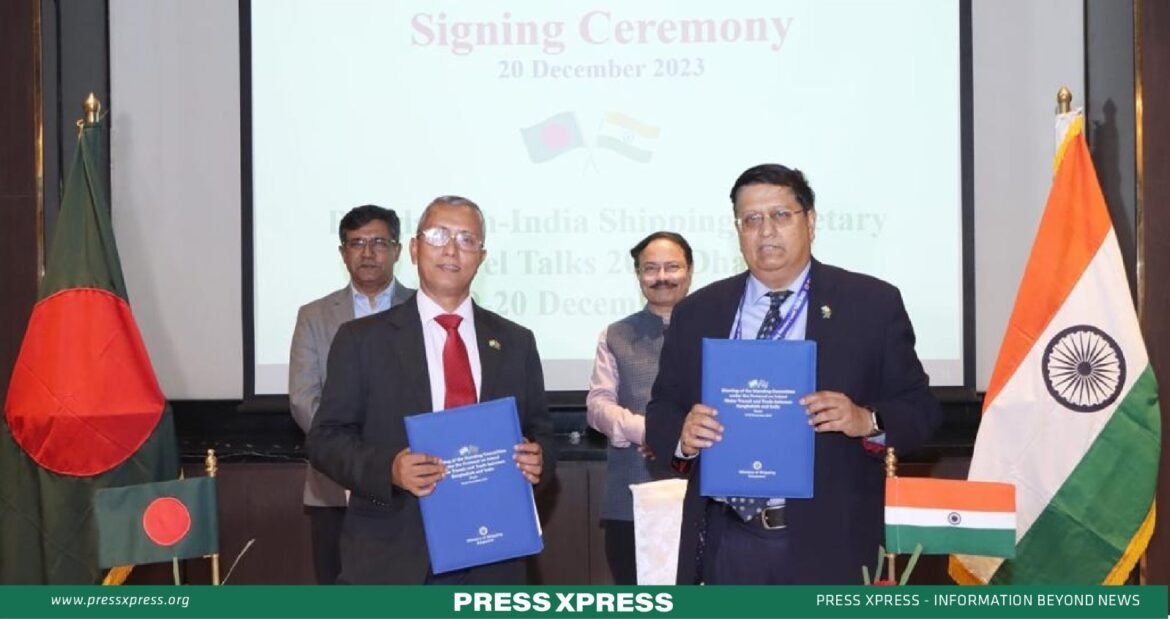Key Highlights:
- Easing of visa issuance, shore-leave facility, and repatriation for seafarers
- Land route at LCS Radhikapur and Hodibari to extend trade and connectivity
- Extend the IBP route and declare Safardighi as a new port of call under PIWT&T
- Inclusion of Payra seaport in the ACMP for movement of goods
In a series of high-level discussions held in Dhaka, the Governments of India and Bangladesh successfully concluded talks to enhance cooperation. The meetings included the Shipping Secretary Level Talks (SSLT), the 22nd Meeting of the Standing Committee (SCM) under the Protocol on Inland Water Transit & Trade (PIWT&T), and the 3rd Meeting of the Inter-Governmental Committee (IGC) on the use of Chattogram and Mongla Ports for the movement of goods.
You can also read: India Stresses Non-Interference in Bangladesh’s Elections
The talks focused on key issues related to inland water transit, trade protocols, and the efficient use of ports for bilateral trade. The successful conclusion of these discussions marks a positive step forward in strengthening the ties between the two neighboring countries.
Amidst a world grappling with supply chain disruptions, diplomatic strategies emerge as key players in shaping a new era of global collaboration in trade and connectivity.
In the meeting, Bangladesh committed to form a joint committee for a shared Automatic Identification System (AIS) on the IBP route, improving vessel navigation and tracking. Both sides also greenlit the addition of the Mongla-Jamtola stretch for passenger and cruise vessels, allowing visits to the Sunderbans area in Bangladesh. Additionally, Bangladesh is poised to submit a proposal for the 80:20 development sharing of IBP routes 5 & 6 and 9 & 10, pending examination by the Indian side for possible implementation.
Inclusion of Payra Sea Port Under Transshipment
In the Inter-Governmental Committee meeting, both nations reached an accord to consider incorporating Payra Sea Port into the Agreement on the use of Chattogram and Mongla Ports for Movement of Goods (ACMP). Furthermore, discussions explored the potential inclusion of the Sabroom-Ramgarh route and vice versa as an additional pathway under ACMP, subject to the availability of essential port, customs, and related facilities.
The talks also addressed issues related to the swift berthing of vessels/barges utilizing ACMP trade routes. These extensive discussions and agreements are anticipated to greatly bolster regional trade and security.
Talking to journalists, Md. Mostafa Kamal said, India has been offered to use Payra port along with Chittagong and Mongla ports. They initially agreed. A decision in this regard may be taken at the secretary-level meeting. In response to a question, he said that this proposal has been made to increase the use of Payra Port.
Agree to extend Indo-Bangla Protocol Route
In a move to boost regional trade and security, Bangladesh and India have solidified agreements under the Protocol on Inland Water Transit and Trade. The pact, derived from their bilateral trade agreement, facilitates commerce and goods passage through waterways. It enables the movement of goods within each country and to third nations through mutual terms.
During Shipping Secretary Level Talks, key topics such as streamlined visa issuance, shore-leave facilities, and seafarer repatriation were discussed. The agreement designates land routes at LCS Radhikapur (Birol) and Hodibari (Chilahati) to amplify trade and connectivity. There’s also consideration for adding Dhamra Port as a Port of Call under the Coastal Shipping Agreement.
Current Trade Relation
Bangladesh and India share a profound historical, linguistic, and cultural bond that goes beyond a mere strategic partnership. India swiftly recognized Bangladesh’s independence in December 1971, establishing diplomatic ties and fostering a lasting relationship based on equality, trust, sovereignty, and mutual understanding.
In the fiscal year 2022-2023, Bangladesh exported a diverse array of 1,155 commodities to India, totaling US$ 2.02 billion, a slight increase from US$ 1.97 billion in FY22. Notable exports include RMG cotton (US$ 510 million), cotton fabrics, made-ups, etc. (US$ 153 million), RMG manmade fibers (US$ 142 million), spices (US$ 125 million), and jute (US$ 103 million). April-May 2023 alone saw exports amounting to US$ 278 million, and these arrangements are expected to boost trade and commerce growth.
On the import side, Bangladesh holds a significant position as India’s largest trading partner in the subcontinent, representing 12% of total imports. The overall trade turnover for the fiscal year reached US$ 14.22 billion. Imports from India to Bangladesh included 6,050 commodities, totaling US$ 12.20 billion in FY23, compared to US$ 16.15 billion in FY22. Key imports encompass various commodities (US$ 1.17 billion), cotton yarn (US$ 1.02 billion), petroleum products (US$ 816 million), other cereals (US$ 556 million), and cotton fabrics, made-ups, etc. (US$ 541 million). In April-May 2023 alone, imports from India reached US$ 1.67 billion.”


